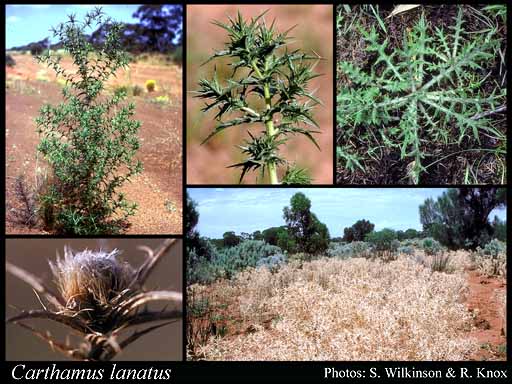- Reference
- Sp.Pl. [Linnaeus] 2:830 (1753)
- Conservation Code
- Not threatened
- Naturalised Status
- Alien to Western Australia
- Name Status
- Current
Erect, spiny annual, herb, 0.15-0.7(-0.9) m high, leaves rigid with spiny lobes. Fl. yellow, Dec or Jan to Apr. Variety of soils. Weed of crops, pastures & waste grounds.







Distribution
- IBRA Regions
- Avon Wheatbelt, Coolgardie, Esperance Plains, Geraldton Sandplains, Jarrah Forest, Mallee, Murchison, Nullarbor, Swan Coastal Plain.
- IBRA Subregions
- Carlisle, Eastern Goldfield, Eastern Mallee, Eastern Murchison, Fitzgerald, Geraldton Hills, Katanning, Lesueur Sandplain, Merredin, Northern Jarrah Forest, Nullarbor Plain, Perth, Southern Cross, Southern Jarrah Forest, Western Mallee.
- IMCRA Regions
- Leeuwin-Naturaliste.
- Local Government Areas (LGAs)
- Bridgetown-Greenbushes, Carnamah, Chittering, Cockburn, Dalwallinu, Donnybrook-Balingup, Dumbleyung, Esperance, Gnowangerup, Greater Geraldton, Harvey, Kalgoorlie-Boulder, Koorda, Menzies, Moora, Northampton, Ravensthorpe, Three Springs, Toodyay, Westonia, Yilgarn.
Management Notes (for the Swan NRM Region)
Alternative Names. Distaff Thistle, Downy Safflower.
General Biology. Growth form. Herb. Life form. Annual. Reproduction. Seed. Dispersal. Water, adhesion, wind, contaminant of grain and wool. Seedbank persistence. 8 years.
Notes. Widely naturalised in warm-temperate and subtropical semi-arid areas, often on low fertility soils in areas receiving 300 to 600 mm of annual rainfall. Germinates mainly in autumn and early winter, however this can be staggered in south-west WA. Most seeds are dispersed close to the parent plant, but some remain in the persistent seed heads. Rates of dormancy can vary among populations at different locations. Most seeds germinate after the first autumn rains 1-3 years following maturation, but some seed can remain dormant and viable for up to 8 years under field conditions. Optimal emergence occurs at or just below the soil surface. Seeds are susceptible to predation by termites. Declared plant in Western Australia, Tasmania, Victoria and several states in the US. Targeted for biological control.
Additional information. Origin. Egypt, temperate Asia, Turkey, Europe.
Suggested method of management and control. Hand remove isolated plants through spring and early summer. Glyphosate at 50% applied by wick or spot spraying with 0.5% glyphosate provides good control. Alternatively spot spray Lontrel® 10 ml/10 L + wetting agent. Best controlled at rosette stage. An integrated program involving a combination of techniques will be most effective. Read the manufacturers' labels and material safety data sheets before using herbicides. For further information consult the Australian Pesticides and Veterinary Medicines Authority to determine the status of permits for your situation or state.
Management Calendar
| Calendar Type | Jan | Feb | Mar | Apr | May | Jun | Jul | Aug | Sep | Oct | Nov | Dec | Comments |
|---|---|---|---|---|---|---|---|---|---|---|---|---|---|
| Germination | O | Y | Y | O | O | ||||||||
| Active Growth | Y | Y | Y | Y | Y | Y | |||||||
| Flowering | Y | Y | Y | Y | Y | ||||||||
| Fruiting | Y | Y | Y | Y | |||||||||
| Manual Removal | Y | Y | Y | Y | Y | ||||||||
| Herbicide Treatment | O | Y | Y | Y | O | O | O |
Legend: Y = Yes, regularly, O = Occasionally, U = Uncertain, referred by others but not confirmed.
References
- Brown, K. & Brooks, K. (2002) Bushland Weeds: A Practical Guide to their Management. Environmental Weeds Action Network, Greenwood.
- Brusati, E. & DiTomaso, J. (2003) California invasive plant inventory assessment form: Carthamus lanatus (woolly distaff thistle). California Invasive Plant Council URL: http://www.cal-ipc.org/ip/inventory/PAF/Carthamus%20lanatus.pdf - Accessed June 2010.
- California Department of Food and Agriculture (2010) Encycloweedia factsheets: Carthamus baeticus smooth distaff thistle, Asteraceae. State of California URL: http://www.cdfa.ca.gov/phpps/ipc/weedinfo/carthamus.htm - Accessed June 2010.
- Department of Primary Industries Victoria (2009) Saffron Thistle (Carthamus lanatus) (Nox). Sate of Victoria URL: http://www.dpi.vic.gov.au/dpi/vro/vrosite.nsf/pages/weeds_herbs_annual_saffron_thistle - Accessed June 2010.
- Faithfull, I. (1998) Landcare notes. Saffron Thistle. Notes Series No. PP0055. Keith Turnbull Research Institute, Frankston. URL: http://www.dpi.vic.gov.au/dpi/nreninf.nsf/Home+Page/DPI+InfoSeries~Home+Page?open - Accessed December 2007.
- Grace, B., Sindel, B.M., Sheppard, A.W. & Whalley, R.D.B. (1999) Ecology and management of Saffron Thistle (Carthamus lanatus L.) in New South Wales pasture. In Proceedings of the 12th Australian Weeds Conference, Hobart 12-16 September 1999 (eds. A.C.Bishop, M. Boersma, C.D. Barnes).
- Grace, B.S., Sheppard, A.W., Whalley, R.D.B. and Sindel, B.M. (2002) Seedbanks and seedling emergence of saffron thistle (Carthamus lanatus) in eastern Australian pastures. Australian Journal of Agricultural Research, 53 (12): 1327-1334 URL: http://www.agric.wa.gov.au/objtwr/imported_assets/content/pw/weed/decp/saffronthistle.pdf.
- Groves, R.H. & Kaye, P.E. (1989) Germination and phenology of seven introduced thistle species in southern Australia. Australian Journal of Botany, 37 (4): 351-359.
- Hussey, B.M.J., Keighery, G.J., Dodd, J., Lloyd, S.G. & Cousens, R.D. (2007) Western Weeds. A guide to the weeds of Western Australia. 2nd Edition. The Plant Protection Society of Western Australia, Victoria Park.
- Moore, J.H. & Wheeler, J. (2008) Southern weeds and their control. DAFWA Bulletin 4744.
- Parsons, W.T. & Cuthbertson, E.G. (2001) Noxious weeds of Australia. 2nd Edition. CSIRO Publishing, Collingwood.
- Peirce, J., Reeves, A. & Rayner, B. (2008) Farmnote 326: Saffron thistle and its control. Department of Agriculture and Food WA.
- Peirce, J.R. (1990) Morphological and phenological variation in three populations of saffron thistle (Carthamus lanatus L.) from Western Australia. Australian Journal of Agricultural Research, 41 (6): 1193 - 1201.
- Peirce, J.R. (1992) The biology of Australian weeds: 23 Carthamus lanatus L. Plant Protection Quarterly, 7 (3): 86-95.
- Peirce, J.R. (1995) Carthamus lanatus L. In The Biology of Australian Weeds, Vol. 1. (eds. R.H. Groves, R.C.H. Shepherd, & R.G. Richardson). R.G. & F.J. Richardson, Melbourne.
- Swarbrick, J.T. & Skarratt, D.B. (1994) The bushweed 2 database of environmental weeds in Australia. The University of Queensland, Gatton College.
- USDA, ARS, National Genetic Resources Program (2009) Germplasm Resources Information Network - (GRIN). National Germplasm Resources Laboratory, Beltsville, Maryland. URL: https://npgsweb.ars-grin.gov/gringlobal/taxon/taxonomysimple.aspx - Accessed October 2009.